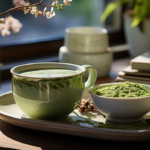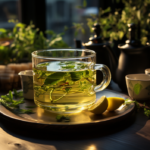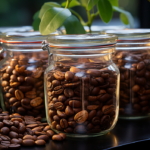Table of Contents
Discover the Secrets of Successful Tea Gardening and Enjoy Fresh, Aromatic Tea at Home!
Hey there tea lovers! Are you tired of paying for expensive tea blends at your local store? Why not grow your own tea garden? Not only is it a fun hobby but it can also be a great way to save money while enjoying fresh, aromatic tea at any time. Growing your own tea garden may seem daunting, but trust me, it’s easier than you think! In this guide, we’ll go over everything you need to know to get started, from choosing the right tea plants to caring for them and harvesting your own tea leaves. So put on your gardening gloves and let’s get started!
Choosing the Right Tea Plants for Your Garden
If you’re interested in growing your own tea garden, the first thing you need to do is choose the right tea plants. With so many different tea varieties out there, it can be overwhelming to know which ones are best for your garden. In this section, we’ll go over some of the most popular tea plant varieties and what you need to know about each of them.
Camellia Sinensis
Camellia sinensis is the plant that is used to make most types of tea, including black, green, and white tea. This plant is a great choice for a tea garden, but it does require some special care. Here are a few things to keep in mind if you decide to grow Camellia sinensis:
- They require acidic soil and need to be protected from direct sunlight.
- They should be watered often, but be careful not to over-water them.
- They prefer a slightly cooler climate, so if you live in a hot area, you may need to find a shady spot for your tea plants.
Mint
Mint is another popular tea ingredient that is easy to grow. Here are a few tips for growing mint in your garden:
- It’s best to grow mint in a pot or container to prevent it from spreading too much.
- Mint prefers partial shade and moist soil.
- It’s important to keep an eye on your mint, as it can be susceptible to pests like spider mites and aphids.
Chamomile
Chamomile is another popular tea ingredient that is easy to grow. Here are a few tips for growing chamomile:
- Chamomile prefers well-drained soil and plenty of sunlight.
- It’s important to keep the soil moist but not over-watered.
- Chamomile can be susceptible to pests like aphids and thrips, so keep an eye out for them.
Lavender
Lavender is a popular flavoring for herbal teas, and it’s also a beautiful addition to any garden. Here are a few tips for growing lavender:
- Lavender prefers well-drained soil and plenty of sunlight.
- Be careful not to over-water your lavender, as it can lead to root rot.
- Lavender can be susceptible to pests like aphids and spider mites, so keep an eye out for them.
By choosing the right tea plants for your garden and following these tips for care and maintenance, you can create a thriving tea garden that will provide you with fresh, aromatic tea for years to come.
Creating the Perfect Environment for Your Tea Garden
Creating the perfect environment is key to growing a thriving tea garden. Before you begin planting, it’s important to understand the specific requirements for tea plants.
Choose the Right Location:
Tea plants thrive in warm, humid environments with plenty of sunlight. Look for a location in your yard that receives 4-6 hours of sunlight daily. If you live in a cooler climate, consider planting tea in a greenhouse or covered area to maintain a consistent temperature.
Prepare the Soil:
The soil quality is essential to the growth and development of tea plants. Tea plants prefer acidic soil with a pH level between 4.5-5.5. You can test your soil using a soil test kit or by sending a sample to a local agricultural extension office for testing. If your soil is not acidic enough, you can add sulfur or acidic peat moss to lower the pH level.
Provide Adequate Water:
Tea plants require consistent moisture to thrive. Make sure to water your plants regularly, especially during periods of drought or extreme heat. Over-watering can be detrimental to the health of your tea plants, so be sure to monitor the soil moisture content to prevent water-logging.
Consider Companion Planting:
Companion planting can be an effective way to promote the growth of your tea plants. Some plants that are beneficial for tea include chamomile, mint, and lemongrass. These plants can help repel unwanted pests and attract beneficial insects to your garden.
In conclusion, creating the perfect environment for your tea garden is essential to growing healthy, flourishing tea plants. Choosing the right location, preparing the soil, providing adequate water, and considering companion planting are all important factors to keep in mind. With these tips in mind, your tea garden is sure to thrive, resulting in delicious, aromatic tea for you to enjoy.
Planting and Caring for Your Tea Garden
Now that you’ve learned about choosing the right tea plants and creating the perfect environment for your tea garden let’s move on to planting and caring for your tea garden. Follow these simple steps to ensure your tea garden flourishes:
1. Prepare the Soil
Before you start planting, prepare the soil by removing all weeds and rocks. Tea plants grow best in well-draining soil with a pH between 5.0 and 5.5. Mix compost or aged manure into the soil to enrich it with nutrients.
2. Planting Your Tea Plants
Choose a spot that gets partial shade and enough sunlight for your tea plants to grow. Dig holes that are twice the size of the plant’s root ball and set the tea plant in the hole. Fill the hole with soil, tamp it down gently, and water the plant thoroughly.
3. Watering Your Tea Garden
Water your tea plants regularly, aiming to keep the soil continuously moist but not waterlogged. In the first year, tea plants require at least an inch of water every week. Allow the soil to dry out slightly between watering.
4. Pruning Your Tea Plants
Prune your tea plants regularly to promote healthy growth and prevent disease. Prune the tips of the branches to encourage new growth, and remove any diseased or damaged branches as soon as possible.
5. Harvesting Your Tea Leaves:
Harvest your tea leaves when they’re young and tender for the best flavor. You can start harvesting when your plants are about 3 years old. Harvest the top two leaves and the bud from each stem by using sharp pruning shears.
Incorporating these simple tips and techniques into your routine will help you grow a thriving tea garden, producing fantastic, refreshing teas for you and your friends to enjoy!
Harvesting and Processing Your Own Tea Leaves
Growing your own tea garden is a rewarding and exciting experience, especially when you get to harvest and enjoy the fruits of your labour. At this stage, it’s important to know the right time to pluck your tea leaves and how to properly process them to achieve the desired flavor and aroma.
Harvesting Tea Leaves
- Knowing when to harvest your tea leaves can be a little tricky, but the size and stage of growth of the leaves can be your guide. Generally, tea leaves are ready for harvest once they’re about 2-3 inches long.
- Some tea plants may produce new leaves every week, while others may grow slower. So, it’s important to keep an eye on the growth of your plants to know when to harvest.
- For the best flavor, it’s recommended to harvest your tea leaves during dry weather and in the early hours of the morning before the sun is too hot.
Processing Tea Leaves
- Immediately after harvesting, spread the leaves on a tray and allow them to wilt for a few hours. Withering the leaves will help remove excess moisture and soften them to prepare for further processing.
- Once the leaves have wilted, you can start rolling them by hand or using a machine to crush them gently. This will help break down the leaf cells and release the enzymes that will eventually oxidize the tea leaves.
- After rolling the leaves, leave them to rest for a while to let the oxidation process begin. The length of time depends on the type of tea you want to produce and the desired flavor profile.
- Finally, dry the processed tea leaves in the sun to stop the oxidation and remove any excess moisture. This will help preserve the flavor of the tea and make it suitable for storage and future use.
Harvesting and processing your own tea leaves may require some effort and practice, but the joy of sipping your own home-grown tea is unparalleled. Remember, freshness is key, so only process the amount of tea that you need at a given time to ensure optimal flavor. Happy brewing!
Conclusion
Growing your own tea garden is an exciting and rewarding venture for tea enthusiasts. Whether you’re looking to save money on store-bought blends or want to experience the freshness of home-grown tea, this guide has given you the essential knowledge to get started. With some planning, dedication, and patience, you can have a thriving tea garden flourishing right in your own backyard. Remember to choose the right plants, create a suitable environment, and care for your tea garden with diligence. Soon enough, you’ll be able to harvest and process your own tea leaves, and enjoy the flavors and aromas of your very own tea blends. Happy gardening!









